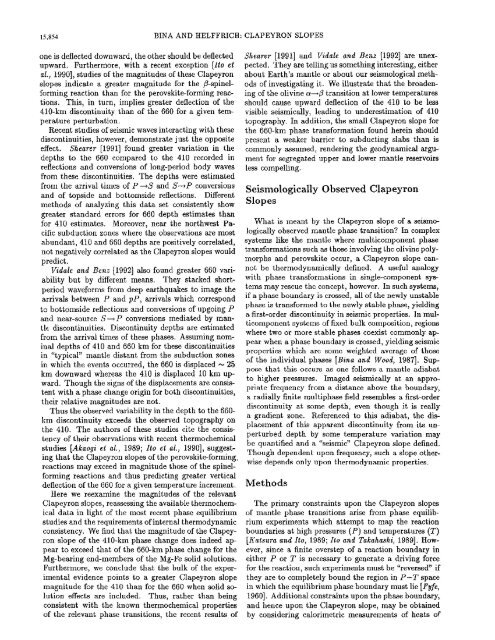Phase transition Clapeyron slopes and transition zone seismic ...
Phase transition Clapeyron slopes and transition zone seismic ...
Phase transition Clapeyron slopes and transition zone seismic ...
You also want an ePaper? Increase the reach of your titles
YUMPU automatically turns print PDFs into web optimized ePapers that Google loves.
15,854 BINA AND HELFFRICR: CLAPEYRON SLOPES<br />
one is deflected downward, the other should be deflected<br />
upward. Furthermore, with a recent exception [lto et<br />
al., 19901, studies of the magnitudes of these <strong>Clapeyron</strong><br />
<strong>slopes</strong> indicate a greater magnitude for the @-spinelforming<br />
reaction than for the perovskite-forming reactions.<br />
This, in turn, implies greater deflection of the<br />
410-km discontinuity than of the 660 for a given temperature<br />
perturbation.<br />
Recent studies of <strong>seismic</strong> waves interacting with these<br />
discontinuities, however, demonstrate just the opposite<br />
effect. Shearer [I9911 found greater variation in the<br />
depths to the 660 compared to the 410 recorded in<br />
reflections <strong>and</strong> conversions of long-period body waves<br />
from these discontinuities. The depths were estimated<br />
CNJIII the arrival lin~es or P +S <strong>and</strong> S--tP conversions<br />
<strong>and</strong> of topside <strong>and</strong> bottomside reflections. Different<br />
methods of analyzing this data set consistently show<br />
greater st<strong>and</strong>ard errors for 660 depth estimates than<br />
for 410 estimates. Moreover, near the northwest Pacific<br />
subduction <strong>zone</strong>s where the observations are most<br />
abundant, 410 <strong>and</strong> 660 depths are positively correlated,<br />
not negatively correlated as the <strong>Clapeyron</strong> <strong>slopes</strong> would<br />
predict.<br />
Vidale <strong>and</strong> Benz [I9921 also found greater 660 variability<br />
but by different means. They stacked shortperiod<br />
waveforms from deep earthquakes to image the<br />
arrivals between P <strong>and</strong> pP, arrivals which correspond<br />
to bottomside reflections <strong>and</strong> conversions of upgoing P<br />
<strong>and</strong> near-source SI-P conversions mediated by mantle<br />
discontinuities. Discontinuity depths are estimated<br />
from the arrival times of these phases. Assuming nominal<br />
depths of 410 <strong>and</strong> 660 km for these discontinuities<br />
in "typical" mantle distant from the subduction <strong>zone</strong>s<br />
in which the events occurred, the 660 is displaced - 25<br />
km downward whereas the 410 is displaced 10 km upward.<br />
Though the signs of the displacements are consistent<br />
with a phase change origin for both discontinuities,<br />
their relative magnitudes are not.<br />
Thus the observed variability in the depth to the 660-<br />
km discontinuity exceeds the observed topography on<br />
the 410. The authors of these studies cite the consistency<br />
of their observations with recent thermochemical<br />
studies [Akaogi et al., 1989; Ito et al., 19901, suggesting<br />
that the <strong>Clapeyron</strong> <strong>slopes</strong> of the perovskite-forming,<br />
reactions may exceed in magnitude those of the spinelforming<br />
reactions <strong>and</strong> thus predicting greater vertical<br />
deflection of the 660 for a given temperature increment.<br />
Here we reexamine the magnitudes of the relevant<br />
<strong>Clapeyron</strong> <strong>slopes</strong>, reassessing the available thermochemical<br />
data in light of the most recent phase equilibrium<br />
studies <strong>and</strong> the requirements of internal thermodynamic<br />
consistency. We find that the magnitude of the <strong>Clapeyron</strong><br />
slope of the 410-km phase change does indeed appear<br />
to exceed that of the 660-km phase change for the<br />
Mg-bearing end-members of the Mg-Fe solid solutions.<br />
Furthermore, we conclude that the bulk of the experimental<br />
evidence points to a greater <strong>Clapeyron</strong> slope<br />
magnitude for the 410 than for the 660 when solid solution<br />
effects are included. Thus, rather than being<br />
consistent with the known thermochemical properties<br />
of the relevant phase <strong>transition</strong>s, the recent results of<br />
Shearer [I9911 <strong>and</strong> Vidale <strong>and</strong> Benz [I9921 are unexpected.<br />
'They are telling us something interesting, either<br />
about Earth's mantle or about our seismological methods<br />
of investigating it. We illustrate that the broadening<br />
of the olivine a+@ <strong>transition</strong> at lower temperatures<br />
should cause upward deflection of the 410 to be less<br />
visible <strong>seismic</strong>ally, leading to underestimation of 410<br />
topography. In addition, the small <strong>Clapeyron</strong> slope for<br />
the 660-km phase transformation found herein should<br />
present a weaker barrier to subducting slabs than is<br />
commonly assumed, rendering the geodynamical argument<br />
for segregated upper <strong>and</strong> lower mantle reservoirs<br />
less compelling.<br />
Seismologically Observed <strong>Clapeyron</strong><br />
Slopes<br />
What is meant by the <strong>Clapeyron</strong> slope of a seismologically<br />
observed mantle phase <strong>transition</strong>? In complex<br />
systems like the mantle where multicomponent phase<br />
transformations such as thosc involving Lhc olivine polymorphs<br />
<strong>and</strong> perovskite occur, a <strong>Clapeyron</strong> slope cannot<br />
be tbermodymamically defined. A useIu1 analogy<br />
with phase transformations in single-component systems<br />
may rescue thc concept, howcvcr. In such systems,<br />
if a phase boundary is crossed, all of the newly unstable<br />
phase is transformed to the newly stable phase, yielding<br />
a first-order discontinuity in <strong>seismic</strong> properties. In multicomponent<br />
systems of fixed bulk composition, regions<br />
where two or more stable phases coexist commonly appear<br />
when a phase boundary is crossed, yielding <strong>seismic</strong><br />
propcrtics which arc somc weightcd avcragc of those<br />
of the individual phases [Bina <strong>and</strong> Wood, 19871. Suppose<br />
that this occurs as one follows a mantle adiabat<br />
to higher pressures. Imaged <strong>seismic</strong>ally at an appropriate<br />
frequency from a distance above the boundary,<br />
a radially finite multiphase field resembles a first-order<br />
discontinuity at some depth, even though it is really<br />
a gradient <strong>zone</strong>. Referenced to this adiabat, the displacement<br />
of this apparent discontinuity from its unperturbed<br />
depth by some temperature variation may<br />
be qnantified <strong>and</strong> a "<strong>seismic</strong>" <strong>Clapeyron</strong> slope defined.<br />
Though dependenl upon frequency, such a slope otherwise<br />
depends only 11pon t,hermodynamic properties.<br />
Methods<br />
The primary constraints upon the <strong>Clapeyron</strong> <strong>slopes</strong><br />
of mantle phase <strong>transition</strong>s arise from phase equilibrium<br />
experiments which attempt to map the reaction<br />
boundaries at high pressures (P) <strong>and</strong> temperatures (T)<br />
[Katsura <strong>and</strong> Ito, 1989; Ito <strong>and</strong> Takahashi, 19891. However,<br />
since a finite overstep of a reaction boundary in<br />
either P or T is necessary to generate a driving force<br />
for the reaction, such experiinents ulust be "reversed" if<br />
they are to completely bound the region in P-T space<br />
in which the equilibrium phase boundary must lie [Fyfe,<br />
19601. Additional constraints upon the phase boundary,<br />
<strong>and</strong> hence upon the <strong>Clapeyron</strong> slope, rnay be obtained<br />
by considering calorimetric measurements of heats of













